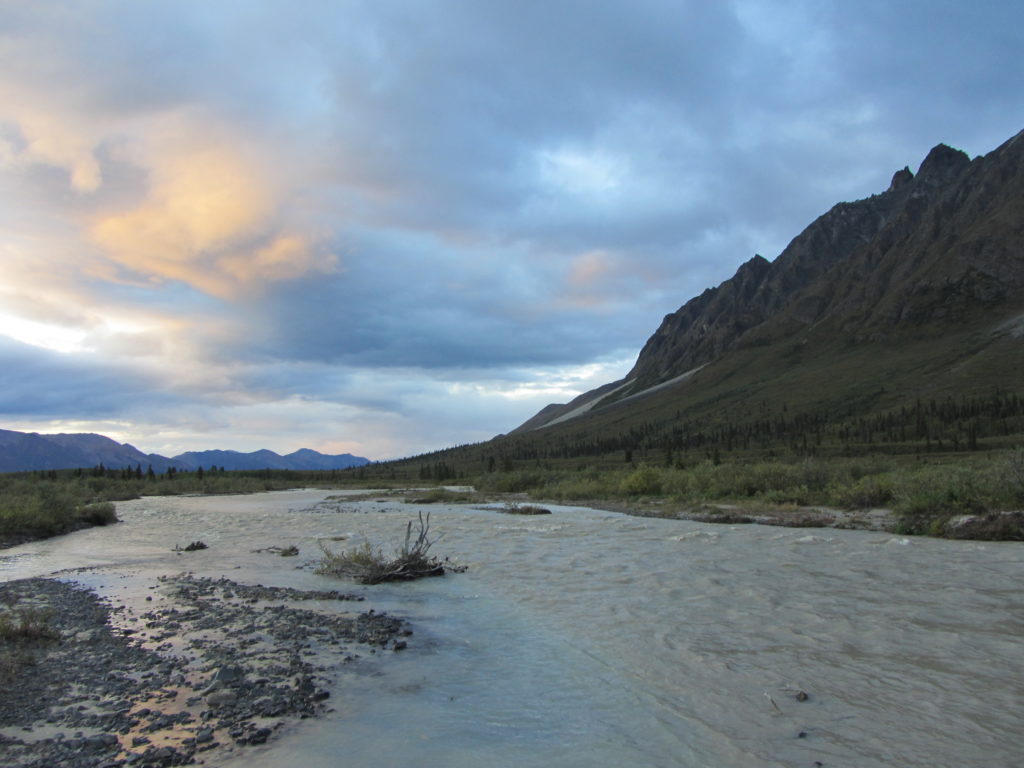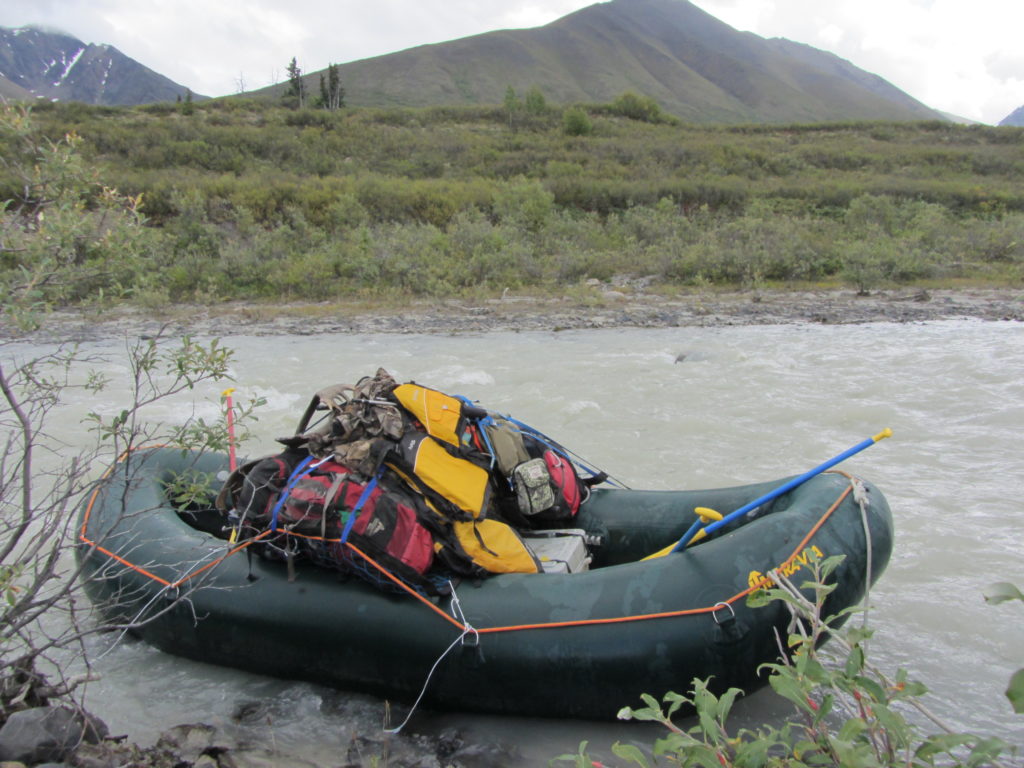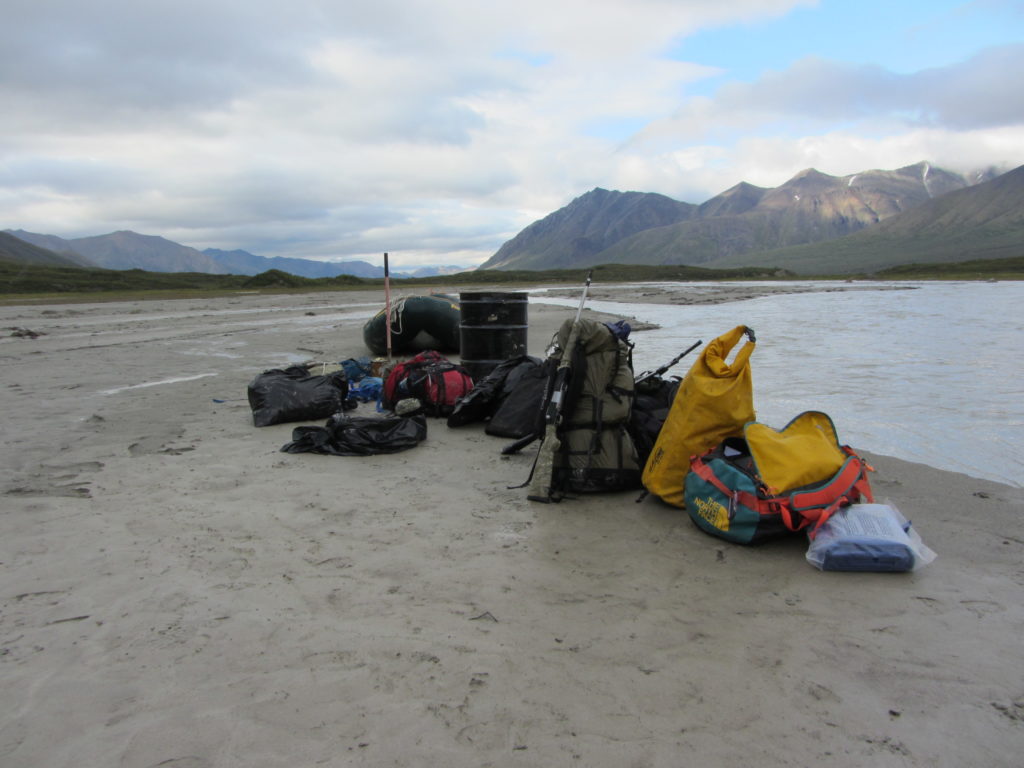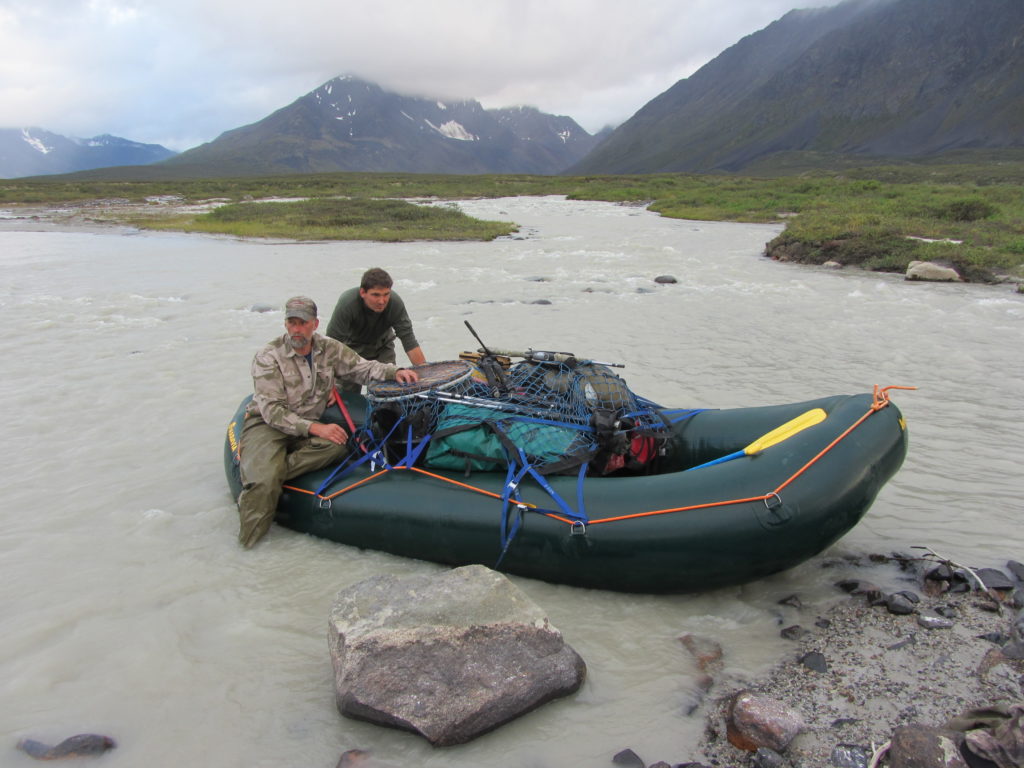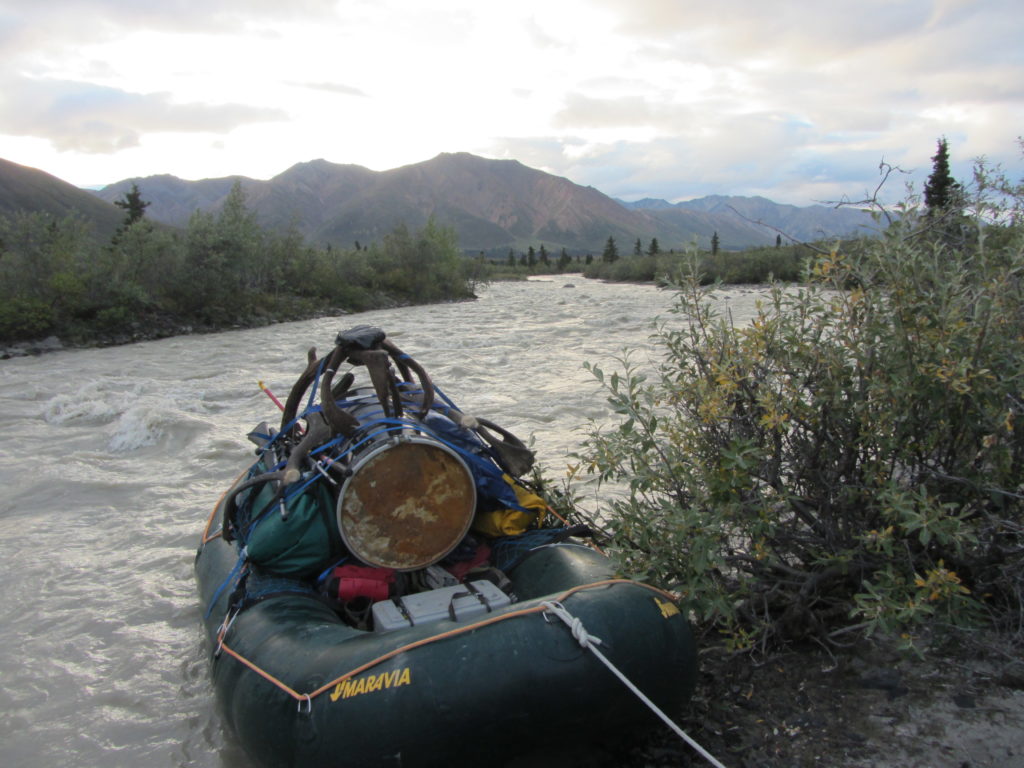Editors Note: Bryan’s submission was originally published in Sports Afield and we would like to thank Bryan and SA for giving us the opportunity to publish his excellent story online.
A chill had crept into the August air. Willows that skirted an opposing mountain had been dappled yellow overnight. And I was trudging along a rocky path no wider than a foot, carved into a sheer descent of rock.
Hidden in the refuge of the Alaska Range, these roads of rubble bend, twist, and turn throughout the mountainsides. Ancient highways seldom used by man. Traffic jams can be common on these roads, though they are never congested with automobiles. Rather, autumn’s evening rush hour consists of throngs of Rangifer tarandus – the caribou.
“How do caribou manage to navigate these trails–” I started to ask my guide Jeff Pralle, when a hunk of stone unexpectedly dislodged beneath me, causing me to lose my foothold.
I quickly righted myself – like a tightrope walker – and gaped at the sizeable stone as it plummeted some 2000 feet below.
“–without falling to their death?” I finished asking, trepidation in my voice.
“Four legs,” he quipped. “It’s time you got yours. This isn’t the first time you’ve been in these mountains,” he said with a gruff chuckle.
Over the next hour I slipped and stumbled awkwardly among the loose rocks. Jeff, whom I believe is part mountain goat, had pulled ahead by 30 yards, but it seemed like 3 miles. He was resting on a stony perch, scanning the distant terrain through his binoculars, when I caught up with him.
“Down there,” he whispered, pointing to a faraway and treeless patch of land barely visible to the unaided eye.
“Negative,” I answered, fixing my binoculars in the general direction to where Jeff had pointed.
“Give this a try,” he said, motioning for me to take a look through his spotting scope.
Through the scope’s eyepiece, I delighted in watching a lone bull caribou frolic under a canopy of ashen clouds. He looked majestic – adorned with a crown of polished antlers, his head pitched back, and white muzzle aimed toward the sky. The bull shook those gleaming antlers from side to side, as if shadow boxing in preparation for the many battles he would face during the rut. It was then and there, that nature’s great wanderer had captivated me for the first time.
“Well…what do you think Mr. Judge?” Jeff asked, as I pulled my gaze away from the scope.
“What a head! Looks like we should go after this one,” I eagerly replied.
As though in answer, Jeff was already on his feet, pack strapped to his back, ready to lead the way.
The rain lashed at our faces as we began our slippery descent. Fierce showers had materialized without warning at least two dozen times in the past four days. “Rainy Pass area…aptly named,” I said to Jeff, shielding my face from yet another onslaught.
My words seemed to go unheard, for Jeff was determined to get us within shooting distance of that bull.
“He’s only one of about fifteen hundred in the Rainy Pass herd. No more than a dozen bulls are harvested from this herd each year by hunters,” he said a few minutes later, as we rested our legs.
It was here that I took a moment to notice that even with the gusts of rain, the countryside was inspiring – the broad, silvery sweep of the glacial headwaters of the Kuskokwim River snaking through the endless green and red vale, and the towering mountains beyond, thrusting into the clouds’ gray.
Four hours had passed since we began our climb down the mountain. We were now standing on the bank of a murky pond glassing for the bull. All around us it was quiet except for the sounds from a beaver’s tail smacking water, and the patter of rain as it collided with the foliage of the taiga. Then a “crack” from behind caused both of us to spin around with a start!
Expecting to see a grizzly, I was relieved to see it was only our assistant guide, Leopold Korzybski, tromping through the willows. He had separated from our party a day earlier to drop off supplies at a support camp tucked alongside the river’s edge. Dripping wet and cold from rain, the three of us scarfed down some warm granola with blueberries. With the concoction under our belts the cold day became a bit warmer, and the surrounding mountains smaller.
“Let’s move out, daylight is fading, and so are our chances,” said Jeff, his eyes trained on the horizon.
With the sun going down over the Revelation Mountains, we hastily made our way toward the swale where the bull had been frolicking. An hour passed before we paused on a lush hilltop to glass some more. High above, on a rugged slope, rested several cows and bulls – but not the bull we were after. With senses honed from thousands of years of evolution and predation by wolves, they would not fail in detecting our presence for long. And with the trophy bull nowhere in sight, it was obvious that he already beat them to the punch.
The River Runs Cold and Dangerous
I awoke the next morning to another steel colored sky. My desire for Rangifer burned bright – like the indigo flame emanating from the camp stove we huddled over. As if to taunt me, a caribou cow with a respectable set of antlers grazed unconcerned along the riverside near our support camp.
“It’s good to see the caribou are making a comeback in this area,” said Jeff, while slurping some coffee.
“What do you mean?” I asked.
“Wolves…depredation,” he replied, staring through me.
Jeff’s response made me recall Russell Annabel’s observations about the relationship between this apex predator and caribou almost 70 years earlier, “Probably the wolves have done the greatest damage. Every woodsman you meet in the north has tales to tell of their bloody assaults on the herds.”
Still in thought, I hardly noticed that Jeff and Leopold had tossed the dregs of their coffee into the weeds, and began readying an inflatable raft for the next leg of our journey.
“Time to float the river,” said Jeff.
His words sent a shiver down my neck. I had experienced the wilds of Alaska in many ways, but never before floated one of its rivers.
“How do you plan on fitting all our equipment into that?” I asked, pointing to a green raft that looked like a pool toy sitting next to all of our gear.
“We’ll be pulling you behind it,” Jeff replied in jest.
It took more than an hour to load and secure all of the equipment. Weighted down by backpacks, a cooler, dry sacks, rifles, a 55-gallon drum, and other miscellany our boat looked more like a garbage barge than an inflatable raft. Room in the raft was at a premium; Leopold and I each straddled one of the forward gunwales, while Jeff commandeered the stern. With the current running cold, harsh, and swift the three of us pushed off into the uncertainty of the dangerous water.
“It’s going to be a rough first mile!” shouted Jeff.
“The river is down to less than a foot–” he started to say, but his booming voice was drowned out by the rushing sound of the glacial runoff fighting its way down the rock-strewn riverbed.
Without warning our raft shuddered. The boat had just slammed into a smooth boulder barely visible below the river’s silt-choked surface.
“Was that a house?” I asked, wiping cold spray from my face.
“Keep paddling!” yelled Jeff.
Fingers numb, and knuckles white; I paddled hard against the current.
“I thought climbing mountains was tough!” I exclaimed.
“Nobody said it was easy!” barked Jeff.
The raft bucked and then started to spin. And spin. For a few harrowing moments we were unable to control the raft, bracing ourselves for the next impact. Icy water kept pouring over the sides of the raft and into my hip boots. Caught by an eddy, the bow was now facing downriver. But the inflatable continued to slam into boulders, and carom off others before flying through a narrow chute into a relatively calm stretch.
I assumed the worst was over. Yet, all of us were unsettled by a dreadful grating sound from below. The raft had hit bottom and come to a standstill.
“Everyone out and push!” Jeff shouted, as frothy water rushed past.
My arms and legs burned, struggling to push the waterlogged raft off the gravel bar. The river’s mighty force was little help in dislodging the raft. Suddenly, the grating sound resumed and the raft lunged forward.
“On board!” Leopold warned, as a wall of foaming water hurled itself against the raft.
We were running the rapids once again. But the exhilaration didn’t last for long. We bottomed out at least six more times in less than a mile. Each time, the process of heaving the raft from the riverbed left us more drenched and exhausted than the last. Water blanketed the floor of the raft. So much in fact, that I wondered how the raft was still afloat.
“Paddle hard…we need to get to shore!” Jeff roared.
Waves crashed, Leopold and I frantically paddled, Jeff steered, and the raft cut wickedly to the left.
“Harder!” I heard Jeff yell from behind.
Then the bottom of the boat made that terrible grating sound. But this time it was a welcome one. Our raft had finally come to rest ashore.
Where we landed along that crazy river, I had no clue. It didn’t matter – we were all in one piece. Warm rays now pierced the clouds, but I shivered, despite the sunshine.
“Never a dull moment with you two!” I blurted to Jeff and Leopold, as we hastily unloaded the raft.
“The next stretch will be like a lazy river,” Jeff answered, with a laugh.
After unloading all of the gear, and draining gallon upon gallon of water from the bottom we flipped the raft over. I stared in fascination at the handiwork of the turbulent river. The raft’s bottom looked like a moth-eaten cloth. Thirteen holes, many larger than a half-dollar, would have to be repaired before the battered boat was seaworthy again.
Shangri-La
We hopped back into the haggard raft just after daybreak. The weather conditions mirrored the day before – clouds and rain. As we glided past its stony banks, the river seemed deeper and a bit gentler. This is a good thing, I thought, since numerous PVC patches were now helping keep our raft afloat.
“Where are we headed?” I asked Jeff, shouting over my shoulder to overcome the roar of the rushing water.
“Shangri-La…keep paddling,” he replied.
We kept navigating the fickle river for three more hours. Occasionally, we would stop and search for any signs of wildlife on the mountainsides. But they were cloaked in the shadows of clouds, and each time our efforts went unrewarded.
Around 2:00 PM we reached our goal – a large bend in the river where the trailhead to Shangri-La was concealed among brushy undergrowth. We removed our gear and the 55-gallon drum from the raft. Leopold tied the raft to a tree and then let it bob into the middle of the choppy river.
“Insurance from bears,” said Leopold, cinching the rope tight against the tree.
Although the trailhead was not obvious to me, Jeff seemed to be able to find trails where none existed. I followed him without question into a nearly impenetrable thicket of willows. Quick travel was impossible through the tangled trees.
“This is the easiest route,” Jeff assured me.
For two hours we struggled against dense brush, scratching our hands and faces on claw-like branches before finally setting foot onto another ancient highway. I could see that the trail narrowed as it wound its way along the mountain. We would have to hike it in single file.
And hike we did. We clambered all along that ancient highway for miles – backpacks heavy, feet and legs tired – ‘til the sun sank way over the mountains and we could go no further.
“Settle in boys,” said Jeff, as he drove the last tent stake into the ground.
Evening’s air was cold and heavy, and I was anxious for my sleeping bag. That night I slept like the dead.
With the dawn of day seven, everything changed. Not the weather, mind you, but my good fortune.
“Over there,” Jeff said quietly, despite the howling wind.
I peered through the spotting scope. My jaw dropped as I focused the scope. A bull caribou, with a huge rack of antlers, was bedded with a cow several miles across the expansive and rugged valley Jeff called Shangri-La.
“This one is worth chasing,” said Jeff, his face serious and intent.
I swallowed hard at the thought of our chances of completing a successful stalk. The weather was lousy. The terrain looked intimidating. Plus, we were only a distant threat; the caribou appeared as dark specks against the far-off hillside through my binoculars.
Then I heard Jeff say, “The wind is in our face. Pack light. Let’s move!”
Tired from the previous day’s climb, I was slow to start that morning. Early on, I fell behind. Jeff turned sharply around to face me.
“This is no time for a stroll!” he snapped.
Hearing his words, I quickly forgot what it meant to be tired! The three of us scurried up, down, and around earthen mounds covered with shards of rock, slick with rain. Soon we covered a mile, then another. Fifteen minutes later we were within 540 yards of where the bull and cow remained bedded.
“It’s taken us 40 minutes to cover 3 miles…not bad for Shangri-La,” said Jeff, as I struggled to catch my breath.
“I’d like our chances better if we got a bit closer,” he said, steely-eyed.
For the next half-hour we belly-crawled and crouch-walked to cut the distance. To avoid detection, we even pretended to be caribou by extending our arms over our heads.
“Does this tactic really work?” I asked Jeff, a hint of sarcasm in my voice.
“Yes…get down now…the caribou are just beyond that swell,” Jeff said, pointing to a large knoll in front of us.
We finished the stalk on our bellies. As we cautiously crested the swell, I could see that the bull was now on all fours, casually nibbling on a lichen patch – it’s left side perfectly exposed. I steadied my .308 on my backpack.
“227 yards…whenever you’re ready,” Jeff murmured.
The wind was fierce in my face. My heart was booming; crosshairs pulsed with each beat. I slowed my breathing. My vision became trance-like through the scope. Two shots, a couple kicks from Rangifer, and then it was still.
“Great shots man…that was fantastic!” hollered Jeff, as we gave each other several congratulatory slaps on the back.
It was fantastic! The emotions and energy that coursed through me were beyond electric. Suffice it to say, I felt more than alive at that very moment.
The bull’s antlers seemed to grow in size as the three of us approached its lifeless form. His headgear was heavy and something to observe: 30-plus points, covered in thick velvet, lengthy tines, big double shovels, symmetrical bez, and nearly foot-long back scratchers. To honor the fallen animal, Leopold gave the bull a “last bite” by placing a sprig of leaves in its mouth.
“To connect you with the caribou and nature,” said Leopold, placing another sprig dipped into the animal’s blood in the back of my hat.
Shangri-La was misty wet with rain. I shuddered in the cold breeze as Jeff and Leopold caped and quartered the caribou. Dusk surrounded us by the time we had stuffed our backpacks with meat. After kneeling to hoist the bull’s heavy antlers over my shoulders, we began our journey back to spike camp, beneath a half-moon faintly visible behind a haze of cloud.
Four hours later we reached our tent. I looked up at the sky, comforted by the stars floating in the darkness above. Before retiring that night, we warmed ourselves with pan-fried caribou tenderloin and the complex taste of 18-year-old scotch.
The following morning it was quiet as we walked the ancient highway back to the raft. The sort of quiet that only occurs when you are many miles from civilization. The bulky antlers upon my shoulders felt like being shackled in a pillory, but it was a burden I was glad to bear.
It would take twelve grueling hours to return to the raft that day. During our frequent and necessary breaks, I thought about my hunt and the splendors of Alaska, with its ancient highways and spectacular creatures that travel them. To be amongst them, walking their very paths has been and always will be a tremendous adventure and privilege.
—
Bryan would like to thank his outfitter Xtreme Xpeditions and their highly competent guides and can personally attest to the high standard with which they run their operation. If you’re interested in a hunt like this you can find out more on their website.


